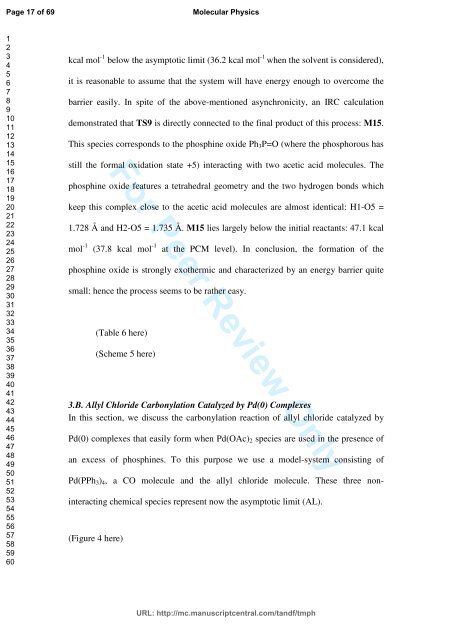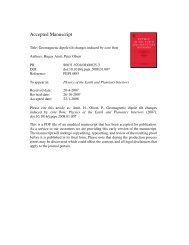For Peer Review Only - TARA
For Peer Review Only - TARA
For Peer Review Only - TARA
You also want an ePaper? Increase the reach of your titles
YUMPU automatically turns print PDFs into web optimized ePapers that Google loves.
Page 17 of 69<br />
Molecular Physics<br />
1<br />
2<br />
3<br />
4<br />
5<br />
6<br />
7<br />
8<br />
9<br />
10<br />
11<br />
12<br />
13<br />
14<br />
15<br />
16<br />
17<br />
18<br />
19<br />
20<br />
21<br />
22<br />
23<br />
24<br />
25<br />
26<br />
27<br />
28<br />
29<br />
30<br />
31<br />
32<br />
33<br />
34<br />
35<br />
36<br />
37<br />
38<br />
39<br />
40<br />
41<br />
42<br />
43<br />
44<br />
45<br />
46<br />
47<br />
48<br />
49<br />
50<br />
51<br />
52<br />
53<br />
54<br />
55<br />
56<br />
57<br />
58<br />
59<br />
60<br />
kcal mol -1 below the asymptotic limit (36.2 kcal mol -1 when the solvent is considered),<br />
it is reasonable to assume that the system will have energy enough to overcome the<br />
barrier easily. In spite of the above-mentioned asynchronicity, an IRC calculation<br />
demonstrated that TS9 is directly connected to the final product of this process: M15.<br />
This species corresponds to the phosphine oxide Ph 3 P=O (where the phosphorous has<br />
<strong>For</strong> <strong>Peer</strong> <strong>Review</strong> <strong>Only</strong><br />
still the formal oxidation state +5) interacting with two acetic acid molecules. The<br />
phosphine oxide features a tetrahedral geometry and the two hydrogen bonds which<br />
keep this complex close to the acetic acid molecules are almost identical: H1-O5 =<br />
1.728 Å and H2-O5 = 1.735 Å. M15 lies largely below the initial reactants: 47.1 kcal<br />
mol -1 (37.8 kcal mol -1 at the PCM level). In conclusion, the formation of the<br />
phosphine oxide is strongly exothermic and characterized by an energy barrier quite<br />
small: hence the process seems to be rather easy.<br />
(Table 6 here)<br />
(Scheme 5 here)<br />
3.B. Allyl Chloride Carbonylation Catalyzed by Pd(0) Complexes<br />
In this section, we discuss the carbonylation reaction of allyl chloride catalyzed by<br />
Pd(0) complexes that easily form when Pd(OAc) 2 species are used in the presence of<br />
an excess of phosphines. To this purpose we use a model-system consisting of<br />
Pd(PPh 3 ) 4 , a CO molecule and the allyl chloride molecule. These three noninteracting<br />
chemical species represent now the asymptotic limit (AL).<br />
(Figure 4 here)<br />
URL: http://mc.manuscriptcentral.com/tandf/tmph
















